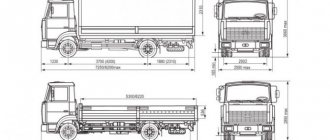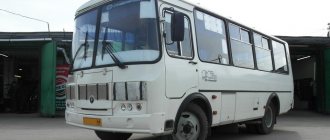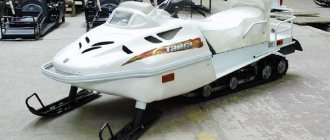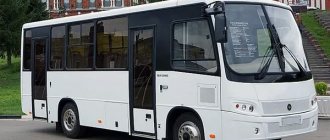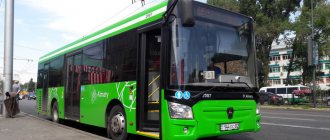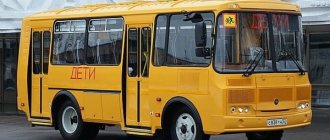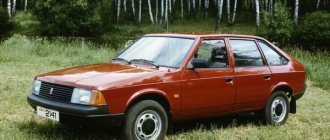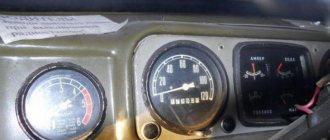Catalog > Pavlovsk Bus Plant (PAZ) > PAZ-32054 / PAZ-32054-07
1952 — 1958
: PAZ-651 / PAZ-651A
1958 - 1961
: PAZ-671 / PAZ-671A
1958 - 1968
: PAZ-652
1963
PAZ-652T
1963 - 1968
: PAZ-652B
1965 - 1989
: PAZ-672
1972 - 1989
: PAZ -3201
1986 - 2000
: PAZ-32051 PAZ-3205 / PAZ-3205-07
1986 - n.d.
: PAZ-3206
2000 - n.d.
: PAZ-32053 PAZ-32054 / PAZ-32054-07 PAZ-32053-70 “School”
2001 - n.d.
: PAZ-4230 "Aurora" / PAZ-4235 "Aurora" / PAZ-3209
2003 - n.d.
: PAZ-3237 PAZ-4234
2004 - n.d.
: PAZ-3204 PAZ-3203
DescriptionHistoryPhoto galleryLinks
Go to photo gallery Go to photo gallery
Small class bus PAZ-32054: history and description
The PAZ-32054 small-class bus is one of thirty modifications of the base model of the most popular Russian bus of the 90s and 2000s, PAZ-3205. A distinctive visible feature is the two-door interior layout, but if you look deeper, a number of technical innovations will be revealed. After gradual modernization, the vehicle became more reliable, consumer characteristics and service life increased.
Humble worker
In December 1989 at the Pavlovsk plant named after. A.A. Zhdanov (Nizhny Novgorod region, Pavlov) the PAZ-3205 small-class suburban and city bus model, which became legendary, was launched into production during its “lifetime”. They can be found in every city in the country, because this four-wheeled worker has become the most popular bus produced in the country. In total, more than 30 modifications of this model have been developed, ten of which are mass-produced. One of them is the PAZ-32054 bus.
Despite its modest appearance, the nimble “groove” has proven its usefulness on city streets crowded with cars, on suburban routes with low passenger traffic, and as special transport in organizations, enterprises, and educational institutions of various profiles. And two PAZ-32054 automatic doors are much more convenient than one.
A little history
25 years ago, no one imagined that the PAZ-3205, which had just entered the production line, was destined not only for a bright life, but also for the opportunity to break the longevity record of its predecessor, the PAZ-672. The bus was not a consequence of the planned renewal of the model range.
On the contrary, it was the result of the refusal to produce the more advanced PAZ-3203 model, the components for which were not supplied by related organizations.
The designers of the plant found a compromise solution - they combined the new body with the old chassis, naturally, making all possible modifications to the latter.
The first prototype of the PAZ-3205 was assembled in the summer of 1979, only a decade later it entered production. Despite a significant percentage of unification and external similarity with buses of the 3203 series, 3205 differed in interior layout and had a number of design differences in the body. A year later, the factory workers presented the predecessor of the modern PAZ-32054 - a two-door modification of the PAZ-32051.
Design Features
The basic chassis has become common to the entire large family of new “grooves”.
One of the significant features is the original pneumohydraulic braking system, which made it possible to eradicate one of the main problems of the PAZ-672 - the insufficient efficiency of service brakes with a hydraulic vacuum drive.
The steering mechanism has also changed - the use of a “screw-ball nut” type with a built-in hydraulic booster (from MAZ-5336) made it possible to reduce the number of flexible hoses by 60%, increasing the reliability of the unit.
The suspension was not left without attention: narrowing the spring track made it possible to reduce the turning radius, and elongated front springs, together with the installation of correction springs in the rear suspension, increased the smoothness of the ride. The body design of most versions was the same. This also applies to PAZ-32054, the photo of which, if you close your eyes to the additional door, looks like two peas in a pod to the photos of PAZ-3205. In 2013, after a slight restyling, the design of the headlights changed - they became rectangular.
Line-up PAZ-32054
The technical characteristics of this modification are significantly improved compared to the base model. The body acquired two doors in the middle and at the end of the cabin.
Unlike standard single-door options, this innovation has made it much easier to board and disembark passengers and increased the safety of the vehicle: in the event of an accident or technical breakdown, people can evacuate from the cabin more quickly.
Due to the appearance of additional doors, the seating arrangement has changed, and the number of seats has decreased slightly.
Power point
Initially, it was decided to install two powertrain options under the hood – gasoline and diesel. While gasoline engines (produced by ZMZ and MMZ) have proven themselves to be excellent, unforeseen problems arose with diesel engines.
The domestic GAZ-542 and the Japanese Hino W04CT were considered as diesel units.
The first diesel “Paziks” entered testing in 1987, but due to the complexity of the layout, the “Gaz” engine dropped out of the race almost immediately, and the expensive Japanese diesel engine was installed in the PAZ-32054 only on order since the early 90s.
The direction of driving on liquefied gas has also developed. Back in 1987, technical specifications and technical documentation were prepared for a bus with propane gas equipment, prototypes of which were built in 1987-1989. Development work on these machines was carried out jointly with designers from the PAZ, GAZ and ZMZ plants.
Now PAZ-32054 (technical characteristics are given below) has two types of execution:
- actual modification 32054 with gasoline engines produced by ZMZ;
- 32054-07 with gasoline MMZ.
The table shows the characteristics of each model:
| 32054-07 | 32054 | |
| Motors | MMZ D-245.9E2MMZ D-245.9E3MMZ D-245.7E2 | ZMZ 52342.10ZMZ 5234.10 |
| Power, l. With. | 130130117 | 124130 |
| Speed (max), km/h | 96 (class II)85 (class I-II) | 90 (class II)80 (class I-II) |
| checkpoint | SAAZ 136 or SAAZ 3206 | GAZ-3307 |
| Cylinders | 4R | 8V at 90° |
| Environmental standards | Euro-3 | Euro-3.4 |
PAZ-32054: characteristics and advantages
- Body type: load-bearing, carriage-type, all-metal.
- Number of passenger seats: 18-23 seated, 38-43 shared.
- Width/length/height: 2530/7000/2880-2940 mm.
- It features reliable suspension on any road.
- Improved consumer characteristics.
- High maintainability.
Conclusion
A simple, easy-to-repair design, compact size, efficiency, high payback and low (relative to competitors) cost allowed the “groove” to win the hearts of operating organizations and passengers.
Source: https://autogear.ru/article/180/888/avtobus-malogo-klassa-paz—istoriya-i-opisanie/
Catalog of spare parts for PAZ-32053 (32053, 32054):
Our catalog contains all the spare parts used in the PAZ-32053.
Select the node you need. To make it easier to find spare parts for the PAZ-32053, you can use the quick filter. Quick Filter by nodes:
- Body
BodyBody base with bumpers and towing eyes
- Floor covering and wheel arch covers
- Windshield wiper assembly with brush drive and windshield water cleaning pump
- Front assembly with glazing and ventilation
- Right body side with glazing
- Rear body with glazing
- Body cover
- Passenger door with glazing
- Driver's seat
- Ventilation and heating system
- Interior handrails
- Wheel mudguards
- Engine
Engine
Engine
- Engine mount
- Cylinder block and cylinder head
- Crankshaft, pistons and connecting rods
- Camshaft, valves and tappets
- Inlet and outlet gas pipelines
- Oil sump, oil scraper and oil pump assembly
- Oil pump and distributor drive
- Radiator oil and oil filter
- Crankcase ventilation and air filter
- Fuel tank with fuel line
- Muffler and muffler pipe suspension
- Cooling system radiator
- Clutch
Clutch
- Transmission
- Cardan shafts
- Rear axle (manufactured by JSC KAAZ)
- Suspension
Front suspension
- Front axle (manufactured by JSC KAAZ)
- Wheel disc with rim and decorative caps
- Steering control
Power Steering with Pipes
- Braking mechanisms of front and rear wheels (manufactured by JSC KAAZ)
- Electrical equipment
Bus electrical equipment
- Panel and instrument cluster with flexible shaft
Spare parts diagrams and components are presented on the website for reference purposes! We do not sell all spare parts for PAZ-32053 presented in this list, but many of them.
Bus PAZ 32054
Small bus PAZ 32054 for suburban and urban routes
PAZ 32054 is a two-door modification of the standard model.
Buses of this brand are being gradually modernized in order to increase consumer characteristics and reliability. The basic equipment of the bus includes an engine brake.
It is also possible to convert it to operate on gas fuel, both compressed and liquefied.
Since the fourth quarter of 2011, the PAZ bus has been equipped with engines that comply with EURO-4 environmental standards, including YaMZ-534.
For operation in northern conditions, the manufacturer provides options with double glazing of the side windows and insulation of the passenger part of the cabin. Also in this version, R19.5-inch wheels can be optionally installed.
Competitive advantages of PAZ 32054:
- Affordable price;
- Increased consumer suitability;
- Ease of repair and maintenance;
- Quick payback when transporting passengers;
- Price and availability of spare parts;
- Reliability of the suspension design, regardless of operating conditions.
PAZ 32054 buses are covered by a warranty
- For models equipped with a diesel engine: 18 months/50 thousand kilometers
- For models equipped with a gasoline engine: 2 years/60 thousand
Basic characteristics of PAZ 32054:
- Affordable price;
- Increased consumer suitability;
- Ease of repair and maintenance;
- Quick payback when transporting passengers;
- Price and availability of spare parts;
- Reliability of the suspension design, regardless of operating conditions.
- For models equipped with a diesel engine: 18 months/50 thousand kilometers
- For models equipped with a gasoline engine: 2 years/60 thousand
Basic characteristics of PAZ 32054:
| Body type | Load-bearing, all-metal, carriage-type |
| Body life, years | 5 |
| Wheel formula | 4x2 |
| Length / Width / Height, mm | 7000 / 2530 / 28802940 |
| Base, mm | 3600 |
| Ceiling height in the cabin, mm | 1965 |
| Number / width of doors, mm | 2 / 726 |
| Min. turning radius, m | 7,6 |
| Curb/full weight, kg | 46805575 / 76708415 |
| Load on front/rear axle, kg | 28453240 / 46555350 |
| Total number of seats (including landing seats) | 38..43 / 1823 |
| Fuel tank capacity, l | 105 |
| Front axle/drive axle | KAAZ or RZAA |
| Steering gear | Power steering |
| Brake system | The service brake is a pneumatic dual-circuit drive with division into circuits along the axes, the brake mechanisms of all wheels are drum, ABS. Parking Brake - brake mechanisms of the rear wheels driven by spring energy accumulators. Emergency brake - each circuit of the service brake system. Brake retardation system - engine brake (for PAZ 32054 07). |
| Ventilation | Natural |
| Heating system | Calorifier from the engine cooling system |
| Tires | 245/70R19.5″ (for class I-II); 8.25R20″ (240R508) (for class II and special) |
- For models equipped with a diesel engine: 18 months/50 thousand kilometers
- For models equipped with a gasoline engine: 2 years/60 thousand
THIS IS INTERESTING: Why do trams have big windows?
Source: https://www.uazsp.ru/bus/models/32054/
Technical characteristics of PAZ 32054
| Body type | Load-bearing, all-metal, carriage-type |
| Wheel formula | 4x2 |
| Body resource | 5 |
| Length Width Height | 7000/2530/28802940 |
| Ceiling height in the cabin, mm | 1965 |
| Base, mm | 3600 |
| Number/width of doors | 2/726 |
| Min. turning radius, m | 7,6 |
| Curb/full weight, kg | 46805575/76708415 |
| Load on front/rear axle, kg | 28453240/46555350 |
| Total number of seats (including landing seats) | 38..43 (1823) |
| Fuel tank capacity, l | 105 |
| Chassis, bridge | KAAZ or RZAA |
| Steering gear | Power steering |
| Brake system | The service brake is a pneumatic dual-circuit drive with division into circuits along the axes, the brake mechanisms of all wheels are drum, ABS. Parking brake - brake mechanisms of the rear wheels driven by spring energy accumulators. Emergency brake - each circuit of the working brake system. Brake retardation system - engine brake (for PAZ-32054-07). |
| Ventilation | Natural |
| Heating system | Calorifier from the engine cooling system |
| Tires | 245/70R19.5” (for class I-II); 8.25R20” (240R508) (for class II and special) |
Aggregate characteristics of PAZ 32054
| PAZ-32054 | PAZ-32054-07 | |
| Engine (petrol) | ZMZ 5234.10ZMZ 52342.10 | MMZ D-245.7E2 MMZ D-245.9E3MMZ D-245.9E2 |
| Number and arrangement of cylinders | 8V at 90° | 4R |
| Environmental safety standards E | EURO-3.4 | EURO-3 |
| Working volume, l | 4,67 | 4,75 |
| Engine power, kW (hp) | 96 (130) at 3200 min-191.2 (124) at 3200 min-1 | 86.2 (117) at 2400 min-196.7 (130) at 2400 min-195.7 (130) at 2400 min-1 |
| Max. torque, Nm | 314 at 2250 rpm-1298 at 2250 rpm | 413 at 1500 min-1451.1 at 14001600 min-1446 at 1500 min-1 |
| Location | Anterior, longitudinal | Anterior, longitudinal |
| Maximum speed, km/h | 80 (for class I-II);90 (for class II) | 85 (for class I-II);96 (for class II) |
| checkpoint | GAZ-3307 | SAAZ 3206 or SAAZ 136 with direct and overdrive gears |
Didn't find the bus? Wrong description? Write about it!
Source: https://bus-club.ru/katalog-avtobusov/paz/paz-32054/
Design Features...Technical Specifications
| PAZ-32054 real reviews about fuel consumption Various types of engines have been installed on the bus throughout the history of production, among which the most common is the carburetor gasoline engine ZMZ-5234, diesel MMZ-245. On these modifications, factory installation of gas-cylinder equipment for operation on liquefied petroleum gas or compressed natural gas began. |
Photo by Pazik • The fuel tank, as on the base model, is 105 liters.
Groove 32054
Paz 32054 is a two-door bus, with a ZMZ-5234.10 gasoline engine, on KAAZ axles with a pneumatic braking system with ABS. The total number of seats is 42 (23 seats), semi-soft seats with low backs.
Paz 32054 bus is produced at the domestic Pavlovsk Bus Plant LLC, which produces more than a dozen different types of city and suburban buses. The plant is constantly improving product quality, developing new modern models in various modifications.
Paz 32054 has gained great popularity in the domestic automotive market. This model is distinguished by its simplicity and ease of maintenance, due to which it is in great demand in all regions of Russia.
Bus 32054 can be equipped with both diesel and gasoline engines, and several interior layout options are provided.
Small buses of this model provide high maneuverability in difficult city conditions, and also make it possible to easily carry out regular transportation of passengers.
Specifications
| Bus class | small |
| Purpose | urban/suburban |
| Length Width Height | 7000 mm / 2500 mm / 2960 mm |
| Base | 3600 mm |
| Curb weight, gross | 5130 / 8185 kg |
| Minimum turning radius | 7.6 m |
| Maximum speed | 90 km/h |
| Control fuel consumption | 20.5 l per 100 km |
| Fuel tank capacity | 105 l |
| Total number of seats (including landing seats) | 42 (23) |
| Engine/gearbox/axle life | 300000 km |
| Body resource | 6 years |
| Interior heating system | Air, heat-using cooling system |
| Availability of ABS | There is |
| Steering | MAZ-64229 with hydraulic booster |
| Number of doors | 2 |
| Chassis type (axles) | KAAZ |
Body
Carrier, carriage arrangement.
Seats
Semi-soft, non-adjustable, upholstery - leatherette
Brake system
Working: Pneumatic, dual-circuit, with division into circuits along the axes, drum brakes on all wheels, ABS
Parking: Drive from spring energy accumulators to the brake mechanisms of the rear axle wheels
Engine
ZMZ-5234.10, gasoline, four-stroke
Number and arrangement of cylinders: 8, V-shaped
Working volume: 4.67 l
Power: 96 kW. (130.56 hp) at 3200 rpm
Torque: 320 Nm. at 2250 rpm
Compliance with toxicity standards: EURO-3
Transmission
GAZ 3307, mechanical, 4 speed,
Source: https://www.Aist-yar.ru/item/570/
Standard value of fuel consumption. Buses domestic and CIS countries
Calculation of fuel consumption in accordance with the methodological recommendations “Standards for the consumption of fuels and lubricants in road transport”, introduced by the order of the Ministry of Transport of the Russian Federation dated March 14, 2008 N AM-23-r.
The calculator below attempts to calculate fuel consumption in accordance with the methodological recommendations “Standards for the consumption of fuels and lubricants in road transport”, introduced by order of the Ministry of Transport of the Russian Federation dated March 14, 2008 N AM-23-r.
The calculator was created upon request to calculate fuel consumption for. , you can also read a short discussion of the problem there.
It is clear that it is best to read the specified methodological recommendations (they are everywhere on the Internet), but for the lazy, I will briefly outline the essence of the matter. Recommendations are needed to assess fuel consumption when operating vehicles. For each vehicle model there is a basic norm, expressed in liters per 100 kilometers. For example, for domestic buses it can be found in the reference book that I made specifically for this calculator - Standard fuel consumption value. Buses domestic and CIS countries.
But life, as we know, makes its own adjustments. It is these adjustments that are trying to take into account the methodological recommendations. In accordance with them, the standard value of fuel consumption should be calculated according to the formula, where Qн is the standard value of fuel consumption, l Hs is the basic rate of fuel consumption per vehicle mileage, l/100 km S is the vehicle mileage, km D is the coefficient (total relative increase or decrease ) to normal, %
The correction factor is the sum of all currently applicable factors. For example, when vehicles operate in winter, depending on the climatic region, the norm can increase from 3 to 20%. See the value of winter surcharges to fuel consumption standards for regions of Russia, depending on climatic regions. The same is true when operating a car in high mountains, in a big city, and so on. The idea, I think, is clear.
For buses, the situation is a little more complicated due to the need to take into account fuel consumption for heating the interior. An additional term appears in the formula, where No is the fuel consumption rate when using standard independent heaters to operate the heater(s), l/h T is the operating time of the vehicle with the heater on, h Data for some brands are given here Fuel consumption rates for heating bus interiors and car cabins with independent heaters.
Since the guidelines recommend that for vehicles and brands of heaters not listed in them, the calculation of fuel consumption should be carried out according to the manufacturer’s data, I have provided the opportunity to enter my data. If in the “Or enter the consumption rate for the heater operation” field, enter a number other than zero, then it will participate in the calculations; if you leave zero, then the data is based on the heater table.
For non-obvious parameters, a tooltip appears if you hover the mouse over the text of the parameter, for example, there is such a tooltip for the parameter “Work on public roads with a complex layout.”
The maximum coefficients from the recommendations are taken, and only those that, in my opinion, can be applied to buses are used. So comments and suggestions are welcome.
Paz 32054 - improved version for small passenger transport
In 2002, the Pavlovsk Bus Plant became part of the holding, which today is called the GAZ Group. The new association sought to strengthen its position in the market, and therefore, outdated bus models began to be produced in an improved form. The improved model of the small class PAZ 32054 bus is produced on more reliable axles, and the vehicle's braking system has been changed.
Bus technical characteristics
Instead of the outdated one, the bus was equipped with a pneumatic dual-circuit working system with drum-type shoe brake mechanisms. Spring energy accumulators ensure the operation of the mechanical drive of the parking system, which acts on the brake mechanisms of the rear axle wheels of the new PAZ 32054. In order to increase passenger safety, all buses are equipped with an anti-lock braking system and an auxiliary brake operating from either of the two circuits of the working system.
The buses are equipped with two types of engines, diesel and gasoline. Zavolzhsky Motor Plant supplies 130 horsepower gasoline engines of Euro-3 and Euro-4 class. The working volume of the eight-cylinder four-stroke PAZ 32054 engine is 4.67 liters with a service life of 300,000 km, and fuel consumption from 22 liters per 100 km. Gas equipment can be installed on buses with gasoline engines.
Power steering makes it easier to drive the bus. Technical characteristics of PAZ 32054 vary from model to model. First of all, the designers modernized the bus suspension. The front one is equipped with a stabilizer bar and is attached to the frame using two semi-elliptical springs. The rear leaf spring suspension is equipped with corrective springs and two shock absorbers.
The gearbox is installed, depending on the configuration of the bus, from different manufacturers. Buses with diesel engines are equipped with a five-speed SAAZ-3206, while PAZ 32504 with gasoline engines are equipped with GAZ manual transmissions with four or five gears.
Design features and interior of Pazik
While modernizing outdated models, manufacturers installed on the PAZ 32054 an all-metal carriage-type body, accommodating 38 passengers, with 20 seats. On later models, the total number of seats increased to 42, and the number of seats increased to 23.
Semi-soft seats are not adjustable. All modifications are equipped with the same type of body with a variety of colors that have undergone anti-corrosion treatment. Body warranty for 6 years. For the convenience of passengers, the PAZ 32054 interior is equipped with two doors 725 mm wide; they open using a pneumomechanical drive device.
Bus windows with vents. There are hatches on the roof of the body that provide ventilation in the warm season. They are equipped with seals that prevent moisture from penetrating into the car interior during rains. Negative reviews about the PAZ 32054 interior are caused by the lack of a partition between the driver and the passenger compartment, and shortcomings in the layout of various switches on the dashboard.
An undoubted advantage of all buses is the accessibility of the engine from inside the vehicle, which allows the driver to carry out minor repairs without leaving the vehicle. The sprung driver's seat is also comfortable and can be adjusted horizontally and the back angle can be adjusted.
THIS IS INTERESTING: Taxi in Zelenogradsk
The bus floor has become more convenient for movement around the cabin thanks to a plywood covering and a height of 1965 mm. The body walls are lined with plastic.
At the customer's request, the bus can be equipped with an individual ventilation system and soft seats. For the convenience of passengers, an air conditioning system and stationary tables can be installed.
The PAZ 32054-07 modification with the same dimensions (length 7000 mm, width 2530 mm and height 2880 mm) and a diesel engine received a brake retardation system as standard. The bus is used on suburban and city routes, the turning radius is 7.5 meters. The fuel tank, as on the base model, is 105 liters.
The electrical circuit of the PAZ 32054 is double-circuit, with separate wiring for the passenger compartment and the bus engine, the electrical equipment is designed for 12V. The bus is heated using heaters from the radiator; three additional heaters are installed. They are connected to the engine starting liquid heater and the vehicle cooling system.
The popularity of the PAZ has always been due not only to its versatility, but also to the ability to quickly and inexpensively repair a vehicle. If repairs are necessary, spare parts for PAZ 32054 can be ordered directly from the factory or from GAZ group dealerships. Carriers value these vehicles for their affordable price and quick payback when operating on a busy transportation schedule. The price of PAZ 32504 buses, depending on the configuration, starts from 1,100,000 rubles.
Pazik Photos
Source: https://promplace.ru/passenger-transport-staty-i-obzory/avtobus-paz-32054-1375.htm
History of the enterprise. • History of creation
| Online calculator: Standard fuel consumption value. Buses, domestic and CIS countries In 2007, production was modernized, which made it possible to carry out certification for regular use on busy routes, the service life of the body has significantly increased from 5 to 10 years, a more efficient heater and more comfortable seats are installed in the cabin. Insulated version of the bus for northern regions Double glazing of windows or double glazed windows, insulation of sidewalls, roof, hatches, floor Body paint Basic white. |
| Bus PAZ-4234: history of creation, description, modifications, basic, technical and additional parameters, engine and chassis characteristics, advantages I work on the PAZ-32054 bus of the 1995 model year, which originally belonged to the carrier, and after retirement I bought it for half the cost. Over time, new models appear, adapted to modern passenger requirements, and also very competitive on the market in comparison with European products. |
Bus PAZ 32053 fuel consumption • It is enough to ensure that the level of working fluids does not fall below the minimum mark, and to comply with all the manufacturer’s requirements.
Paz 32054: technical characteristics, bus, dimensions, fuel consumption
The technical parameters of the PAZ 32054 bus can be called universal. This model was a continuation of the line of buses, into which various innovations were introduced. The two varieties have the same chassis and gasoline engines.
Appearance
The history of its creation is quite long, dating back to the seventies of the last century. The model was prepared for launch back in 1979, but production line production began only five years later in 1984. Only in 1989 the model began to be mass-produced in large quantities.
In 2001, one hundred thousand of these machines were already produced; in 2008, improvements were made, in particular, the guaranteed service life was doubled.
Characteristics
The difference lies in the modification of the pneumatic-hydraulic brake system. There is also a hydraulic vacuum drive.
The 32054 PAZ steering uses a nut with an additional hydraulic booster. With this arrangement, the reliability of the unit has increased significantly. There is also no need to use different hoses.
In addition, the spring suspension has undergone changes. The track has become narrower, which has significantly reduced the turning radius of the bus. New springs were also installed, which increased the smoothness of movement. However, externally the model has not changed at all.
Salon and its features
There are two doors in the cabin, powered by a pneumomechanical drive. There is additional ventilation through vents and hatches that are easy to adjust. Professional drivers also speak well of the design of the driver's seat.
Tactical and technical parameters
| Bus class | small |
| Purpose | Urban |
| Vehicle dimensions | 7x2.51x2.962 m |
| Base | 3.62 m |
| Curb weight | 5.3 t |
| Full mass | 8190 |
| Turning radius | 7.7 m |
| Maximum possible movement speed | 95 km/h |
| Fuel storage tank capacity | 107 l |
| Number of seats | 23 |
| Total number of passengers | 42 |
| Engine service life | 300,000 km |
| Body resource | 7 years |
| Number of doors | 2 pieces |
| Chassis type | KAAZ |
Engine and fuel consumption
The Russian GAZ-544 and the Japanese Hino W06ST were used as a gasoline/diesel engine. The main advantage is the ease of maintenance of the power plant. This allows you to repair a gasoline engine in any conditions.
As for cost, the PAZ fuel consumption is only 20 liters per 100 kilometers.
Modifications
The popular PAZ 32054 had the following design options:
- PAZ-3205-10 and 12 modifications run on gas; the model was not sent for mass production;
- PAZ-3205-20. Number of passengers 16. There are several modifications of this car. The cargo compartment can vary from 5.5 to 15.2 cubic meters;
- PAZ-3205-50 premium version. It was produced in the nineties. The seats were more comfortable, but not adjustable;
- PAZ-3205-60 was produced specifically for northern latitudes. It has additional glazing, internal lining and a spare heater.
A separate copy of PAZ-3205-70 is a school bus. Later it was renamed PAZ 32054 07, the technical characteristics of which are similar to the base model. However, there are slight differences:
- there are four steps, and the bottom one is retractable;
- there is a driver signal button;
- parking lights;
- there is a special compartment for schoolchildren’s bags and backpacks;
- passenger seats – 25;
- there is a loudspeaker on the roof;
- A reflective strip is applied along the sides.
It should also be noted that the bus has a manual transmission.
PAZ bus diagram
The plant in the city of Pavlovo (Nizhny Novgorod region) made more than three dozen different modifications of the PAZ 3205. The whole country knows them, this bus has become a real “workhorse”, suitable for use in rural areas and in the metropolis.
Source: https://naperevoz.ru/transport/avtobusy/paz-32054.html
Appearance - Specifications
The lower part of the central false radiator grille is not original Pre-styling PAZ-32053 in Nozhkino, Kostroma region Pre-styling PAZ-32054 with a late light gray false radiator grille in Tomsk School PAZ-32053, Pervomaiskoe village, Tomsk region PAZ-32053, rear view PAZ-32054 restyling 2014 Gas life-saving bus based on PAZ-32053 PAZ-3205. improvement of interior design, installation of an incomplete partition between the driver's seat and passenger seats, upholstery of seats in artificial leather, installation of a protective door strip;
| PAZ 32031-01 (driver 23 seats; Cummins 4ISBeB150) | 150 | 3,92 | 22.7D |
| PAZ 320401-01 (horizontal 52 seats; Cummins B3.9-140) | 140 | 3,92 | 23.7D |
| PAZ 320401-01 (suburban 37 seats; CumminsB3.9-140) | 140 | 3,92 | 22.1D |
| PAZ 320401-03 (driver 26 seats; Cummins ISBeB185B) | 183 | 4,461 | 22.5D |
| PAZ 320402-03 (horizontal 43 seats; Cummins ISBeB185B) | 185 | 4,461 | 21.4D |
| PAZ 32053 (led. 25 places; ZMZ-523400) | 130 | 4,67 | 32,1 |
| PAZ 32053 (approx. 41st place; ZMZ-5234.40S) | 125 | 4,67 | 30,9 |
| PAZ 3205-30 (led 25 seats; ZMZ-511) | 125 | 4,25 | 30,2 |
| PAZ 32053-70 (led 23 m; ZMZ-523400) | 130 | 4,67 | 32,4 |
| PAZ 320538-70 (school 22 places; ZMZ-5234) | 130 | 4,67 | 31,6 |
| PAZ 3206-110-60 (led 25 seats; ZMZ-52340S) | 124 | 4,67 | 30,4 |
| PAZ 3206-110-70 (school 26 seats; ZMZ-5234) | 130 | 4,67 | 32,9 |
| PAZ 3237-01 (horizontal 55 seats; Cummins 4ISBe B150) | 150 | 3,92 | 29.6D |
| PAZ REAL (led 23 seats; Hyundai D 4AL) | 117 | 3,298 | 21.1D |
| PAZ REAL (led 23 seats; Hyundai D4DD) | 140 | 3,907 | 23.7D |
| PAZ buses until 2008 | ||
| Model | Fuel consumption rate, l/100 km | Type of fuel |
| PAZ-3201, PAZ-3201S, -PAZ 320101 | 36,0 | B* |
| PAZ-3205, PAZ-32051 (with engine ZMZ-672-11) | 34 | B* |
| PAZ-3205 (suburban 37 seats) | 31,2 | B |
| PAZ-3205 (suburban 37 seats) (ZMZ-5234.10-8V-4.67-130-4M) | 32,0 | B |
| PAZ-3205-70 (nearby) | 20,9 | D |
| PAZ-32051 (m/g 42 seats) | 29,0 | B |
| PAZ-32051 (m/g 42 seats) (ZMZ-5234.10-8V-4.67-130-4M) | 29,8 | B |
| PAZ-32053 (driver 16 seats, AI-80) | 31,6 | B |
| PAZ-32053 (driver 16 seats, AI-92) | 30,3 | B |
| PAZ-32053-07 (horizontal 37 seats) (D-245.9-4L-4.75-136-5M) | 24,4 | D |
| PAZ-32053R (suburban 37 seats) | 23,2 | D |
| PAZ-32054 (horizontal 38 seats) | 35,4 | B |
| PAZ-320540 (m/y 41st place) | 29,9 | B |
| PAZ-3206 (with engine ZMZ-672-11) | 36,0 | B* |
| PAZ-3206 (suburban 29 seats) | 32,1 | B |
| PAZ-3206 (suburban 29 seats) (ZMZ-5234.10-8V-4.67-130-4M) | 33,0 | B |
| PAZ-3237 (horizontal 55 seats) | 28,5 | D |
| PAZ-4230-02 “Aurora” (m/y 32 seats) | 24,2 | D |
| PAZ-4230-03 “Aurora” (27 seats) (D-245.9-4L- 4.75-136-5M) | 25,6 | D |
| PAZ-4230-03 (horizontal 56 seats) (D-245.9-4L-4.75-136-5M) | 26,7 | D |
| PAZ-4234 (suburban 50 seats) (D-245.9-4L-4.75-136-5M) | 23,9 | D |
| PAZ-423400 (led 50 seats) (D-245.9-4L-4,75-136-4M) | 24,6 | D |
| PAZ-5272 (horizontal 104 seats) (KaMA3-740.11-8V-10.85-240-5M) | 36,5 | D |
| PAZ-5272 (led. 43 places) (KAMAZ-740.11-8V-10, 85-240-5M) | 32,4 | D |
| PAZ-672, PAZ-672A, PAZ-672G, PAZ-672M, PAZ-672S, PAZ-672U, PAZ-672Yu | 34,0 | B* |
| PAZ buses since 2008 | |||
| Model | Engine power, hp | Working volume, l | Fuel consumption rate, l/100 km |
| 1 | 2 | 3 | 4 |
PAZ-3205: technical characteristics and reviews. Engine PAZ-3205:
The PAZ-3205 bus is a 7-meter long vehicle assembled in Russia, at the Pavlovsk plant, and belongs to the small class.
General information
The development of the bus lasted 15 years, and more than 10 experimental models of the car were created. The first test model was produced in 1979, and mass production began in 1984. However, the final form of the model was adopted in 1986.
In December 1989, conveyor production of the PAZ-3205 began, and by June 2001, the plant produced the 100,000th bus of this type.
In 2008, the model was modernized, which made it possible to increase the life of the body from 5 to 10 years, install a better heating system and create a comfortable interior.
History of the car
The prototype of the PAZ-3205 car was the PAZ-665, which was created at the Pavlovsk plant back in 1966. This bus was manufactured in two types - municipal type and tourist type with comfortable seats. In appearance and interior configuration, it resembles the late version of the 3205 model, which is confirmed by the PAZ-3205 diagram.
After the PAZ-665, other types of vehicles were designed and produced, which were very similar to the 3205 model. Thus, in the 70s of the last century, the PAZ-3202 bus was designed in three types: municipal and suburban use, as well as the PAZ-3204 model with high cross-country ability. The latest model was planned to go into production in 1979. However, due to problems with the supply of components, the start of serial production was interrupted.
Model on a new basis
To get out of this situation, it was decided to use the units of a GAZ truck - this is how a modification appeared, which is known as PAZ-3205. The initial prototypes of this model appeared in 1981, but they required some refinement. It was only in 1986 that the Pavlovsk Automobile Plant began producing model 3205 in small volumes.
Mass production of the PAZ-3205 began in 1989 and continued until 1991. This bus was supposed to replace the outdated 672 model, but the collapse of the Soviet Union with a further crisis abruptly stopped the production of buses at the Pavlovsk Automobile Plant. But all the same, no matter how difficult the financial situation at the plant was, the municipal modification PAZ-32051 was launched in 1991, as well as PAZ-320507 in 1995.
THIS IS INTERESTING: What is needed for a taxi license
Some popular bus models and technical options
The bus began to be mass-produced in 1989 in a standard passenger modification, and the PAZ-3205 engine could be either gasoline or diesel made in Belarus.
Thanks to market conditions, the plant began to adapt to the situation and expand its product range, based on the wishes of customers.
At the moment, the automobile plant produces several types and variants of these buses, which differ in configuration and purpose. Below are a number of modifications of the 3205 model:
- PAZ-3205 is the first model in a whole range of PAZ buses. It was equipped with automatic front doors and emergency rear doors, hydropneumatic brakes and an axle from a GAZ car. The bus has been out of production since 2009.
- PAZ-32052 is a modernized model 3205 for minibuses. The main difference from the original version of the car was that it was equipped with gas equipment.
- PAZ-32053 - the model had pneumatic brakes and a carburetor engine.
- PAZ-3205-20 is a cargo-passenger modification of model 3205. It is produced with a cargo compartment in the rear of the bus and with 16 seats. Trunk volume varies from 5-15 cubic meters, depending on the ordered configurations.
- PAZ-3206 is an all-wheel drive vehicle. Mainly used as a school bus.
In addition to the above modifications, model 3205 gave birth to such a vehicle as a pickup truck bus, which is used in the territories of factories and large enterprises. The front part of the bus is placed on the chassis, with an open side platform at the rear.
Depending on the needs of the plant, they can be more or less short, so that workers and the forwarder can be transferred at the same time.
This type of pickup buses, traveling according to the needs of the enterprise in factory areas, can be found on the roads of the city of Pavlovo.
Export variations of the bus
- PAZ-3205-50 is a variation of the “Lux” type, which was developed at the end of the previous century. It differs from ordinary buses in soft non-adjustable seats in the cabin, luggage racks along the windows and a luggage compartment in the rear with a volume of 2 cubic meters. m.
- PAZ-3205-70 is a bus model for the northern regions.
Produced since 1995. A school bus is currently being produced on its basis. The bus configuration includes: a retractable lower step, semi-soft seats with a straight back, seat belts on each seat, a communication key with the driver near each seat. Reflective stripes are pasted along the perimeter of the bus, and a megaphone is mounted on the roof. - PAZ-3205-507 - “tropical” buses for export to hot countries.
The model stands out with a large number of wide windows, occupying more than half of the window area, ventilation hatches on the roof and a modified body design. Such models are popular in Vietnam, Kazakhstan, Uzbekistan and other countries. - PAZ-3975 is a mobile laboratory that examines athletes.
- PAZ-4234 is an extended bus.
The PAZ-3205 device served as the basis for other modifications of the bus, which were not widely used among customers. A total of 18 modifications of the basic type of vehicle were manufactured.
PAZ-3205: technical characteristics
According to technological parameters, the maximum speed of the bus is 90 km/h. At the same time, the optimal speed with a loaded car is 60 km/h. Fuel consumption per 100 km is 23 liters.
The bus has 28 seats and one office space. The total capacity of the cabin is 37 people.
The car has a mass of 4.83 tons and an engine of 88 horsepower. The bus has a dual-circuit pneumatic-hydraulic brake system, as well as a drum parking brake. In addition, it has a 4- or 5-speed gearbox.
The length of the car is 7 m, width – 2.5 m, height – 2.9 meters. The ground clearance of the bus is 32 cm.
Characteristics of PAZ-3205 and its advantages
The Soviet automobile industry was famous for the ease of assembling cars. The cars were built without any bells and whistles, without much convenience or comfort. PAZ-3205 is no exception to this rule.
But it also has its advantages: its design is simple and easy to use, it is durable and has high maneuverability.
And also, importantly, repairing the PAZ-3205 is quite simple and easy, even with your own hands, which cannot be said about modern buses filled with electronics and other devices.
Proof of the reliability of this car is that it is still in use in almost all cities, villages and enterprises in Russia and the CIS. PAZ-3205, the price of which ranges from 300 thousand rubles to 1 million, has earned popularity due to its cost-effectiveness in maintenance and ease of use in almost all spheres of human activity.
Bus in the 21st century
Since 2000, the plant begins to produce reliable modifications of the one-door PAZ-32053 and two-door PAZ-32054. Since 2002, all buses have been equipped with an ABS system.
Since 2007, a comprehensive modernization of the 3205th model has been taking place. First of all, Belarusian and Ukrainian components were replaced with German parts. The joints of the body began to be covered with a special anti-corrosion tape, and the front part of the bus received a gray plastic cladding. The heating system of the bus was also completely changed, allowing the vehicle to be used in severe frosts.
The interior of the car has also changed. The floor began to be covered with well-impregnated plywood, and the walls began to be covered with plastic. The bus also received other improvements, which mainly concerned small design details.
However, all these innovations could not influence the fact that the 3205 models had already become morally and technically irrelevant. The gearbox from the GAZ-53, which has not been produced since 1992, the uneconomical engine, the outdated design - all this has long needed replacement.
Recently, the Pavlovsk Bus Plant has been developing new advanced buses to replace old models.
But current road carriers and municipal authorities prefer to purchase the PAZ-3205, whose technical characteristics do not meet modern requirements, because it is much cheaper than a similar class of vehicle.
Conclusions of the review of the Pavlovsk plant bus
Moscow and other Russian megacities have long replaced their fleet of vehicles with modern buses of European quality. But the rest of Russia still continues to use this bus. Model 3205 has proven itself in all areas of human activity: from transporting passengers to working in rescue, medical, fire and military services.
The outdated technical support of the PAZ 3205 model is perfectly compensated by its low cost, which for local authorities with their constant budget deficit is a panacea in providing city and regional services with inexpensive transport. In addition, this bus is considered the main vehicle for rural residents, again due to its low cost.
The Pavlovsk Automobile Plant does not stop producing these types of buses, but is constantly improving their technical components. So, starting from 2010, buses of this model began to be equipped with the MMZ-245 diesel engine, which allowed saving fuel consumption by 10 liters.
Also a very good solution was to increase the passenger capacity to 50 people and replace the stamped car frame with a tubular one using polymers for external panels.
New bus from the Pavlovsk plant
This technology was fully implemented in the mass production of PAZ-3205 successors - on buses of the PAZ-4230 Aurora family. Of course, this new model is much more comfortable, convenient and modern than its predecessor, however, its cost is twice as high as the 3205 model. Thanks to this feature, we can say with confidence that the “people’s” bus PAZ-3205 and its modifications will have to work on our roads for a long time.
Source: https://www.syl.ru/article/188123/new_paz—tehnicheskie-harakteristiki-i-otzyivyi-dvigatel-paz-
In the gaming and souvenir industry[ | ]… Technical parameters groove 32054
| PAZ-32054 - we explain from all sides In the 1970-1980s, the Soviet Union carried out significant volumes of supplies of self-propelled chassis based on the PAZ-672 bus to Cuba, where the customer mounted their bodies on it. It differs from standard buses in the installation of soft non-adjustable seats in the cabin on the podium superstructure, the presence of luggage racks above the seats along the windows and a luggage compartment with a volume of about 2 m in the rear of the cabin. |
- diesel unit MMZ-245.9, power - 136 hp. With.;
- brakes - drum type with dual-circuit pneumatic drive and Knorr Bemse anti-lock system;
- bridge - KAAZ;
- rigid spring-type suspension.

